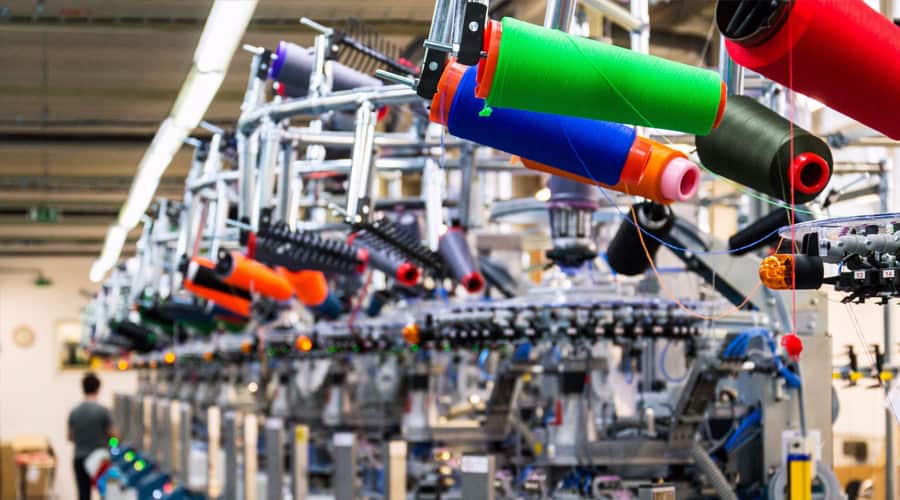
Artificial intelligence can digitize manufacturing processes and automate production in the textile industry.
Do you know the perfect recipe for digital transformation? Well, can’t disclose the whole recipe but can tell one of the major ingredients that go into making the mix- Artificial Intelligence. Many industries have already used AI to enable digitization and gain efficient business growth. The pandemic last year changed the way industries work and almost everything went digital. The textile industry is no exception since they are now slowly adopting AI and automation in transforming their production, manufacturing processes, customer relation, etc.
According to a study published by M Shahbandeh in Statista, the global apparel market is projected to grow in value from 1.5 trillion USD in 2020 to about 2.25 trillion USD in 2025, showing that the demand for clothing and shoes is on the rise across the world. The increase in demand for quality products has led the textile industry to embrace automation and AI to minimize labour and production costs and deliver products according to customer preferences. Another report by Grand View Research says that the global textile market size was valued at 961.5 billion USD in 2019 and is estimated to exhibit a CAGR of 4.3% from 2020 to 2027 owing to the increased demand for apparel in developing countries like China, India, Mexico, and Bangladesh. Textile is a labour-intensive industry and technologies like AI and IoT have helped in easier data processing, predictive analysis, developing smart apparel, and efficiently take up massive work without human intervention. Let us now discuss some of the applications of artificial intelligence that will help transform the textile industry for innovative business developments.
Fabric Pattern Inspection
AI technology like Artificial Neural Network (ANN) helps in defect detection in patterns like weaving and knitting. The AI-enabled vision-based inspection can reduce human errors and increase efficiency. For example, Cognex ViDi developed by Cognex Corp. can automatically inspect fabric patterns. Cognex ViDi leverages machine vision-based technology and it does not require any specific development strategy to implement it into manufacturing.
AI-enabled fabric pattern inspection accelerates manufacturing by reducing pattern defects with minimum labour and maximum precision and accuracy.
AI can be used in fabric defect detection, which is traditionally done by the human workforce by individually analyzing each piece of fabric to understand its quality. Manual detection might take a lot of time and AI will make the process quicker with fewer intrusions. Since the quality of the fabric is significant for maintaining industry value, it is better not to compromise it.
AI in Pattern Making
Pattern cutting and pattern making is a crucial process in the textile industry in which fabrics are cut according to the design and they make different patterns on the fabric. Computer-Aided Design (CAD) is an AI subset that enables computerized pattern making. Here, designers can make the basic structure of patterns and digitize them. CAD is used in cutting patterns where it provides 3-D images of the fabric and designs which makes visualization easier.
Supply Chain Management and Merchandising
AI can be used to automate transportation and packaging in textile industries. Supply chain management is important to manage the smooth flow of materials between retailers and manufacturers. Good supply chain management demands huge storage spaces, better warehouse management, product segregation, and better communication. AI can provide all these benefits through robotics, RPA, machine learning, IoT, and other technologies.
Merchandising is yet another space that can leverage AI to analyze and process data chunks, personalize customer experiences, track customer behaviour, and predict market trends. AI-enabled technologies like data analytics, NLP, and virtual assistants ensure effective communication between manufacturers, production endpoints, retailers and consumers.
Smart Apparel and More
The future textile industry will leverage AI to develop more innovations like smart clothing. Smart apparels have sensors and integrated technology which monitor our body and health condition through biometrics. Further, this technology will help in self-detecting irregularities in heart rates, and consistent monitoring can even help diagnose heart-related diseases. Intelligent clothes can benefit the sports and fitness industry by tracking training progress, monitoring physical state, predicting injuries and helping people analyse their health in near future.
The future of the textile and fashion industry seems bright with AI in place. AI can increase productivity, help in fibre identification, safer working conditions, demand forecasting and more. A Forbes article on the fashion industry says, “Increasingly, fashion brands are using AI and machine learning to maximize users’ shopping experience, improve the efficiency of sales systems through intelligent automation, and enhance the sales processes using predictive analytics and guided sales processes.”
AI will have a huge role to play in redefining the textile industry in the coming years, by enhancing business growth and introducing sustainable fashion.
Share This Article
Do the sharing thingy
Source: https://www.analyticsinsight.net/artificial-intelligence-redefining-and-innovating-the-textile-industry/